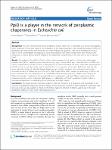PpiD is a player in the network of periplasmic chaperones in Escherichia coli
Matern, Yvonne
Barion, Birgitta
Behrens-Kneip, Susanne
Background: The inner membrane-anchored periplasmic folding factor PpiD is described as a parvulin-like peptidyl prolyl isomerase (PPIase) that assists in the maturation of the major beta-barrel outer membrane proteins (OMPs) of Escherichia coli. More recent work however, calls these findings into question. Here, we re-examined the role of PpiD in the E. coli periplasm by analyzing its functional interplay with other folding factors that influence OMP maturation as well as general protein folding in the periplasmic compartment of the cell, such as SurA, Skp, and DegP. Results: The analysis of the effects of both deletion and overexpression of ppiD on cell envelope phenotypes revealed that PpiD in contrast to prior observations plays only a minor role, if any, in the maturation of OMPs and cannot compensate for the lack of SurA in the periplasm. On the other hand, our results show that overproduction of PpiD rescues a surA skp double mutant from lethality. In the presence of increased PpiD levels surA skp cells show reduced activities of both the SigmaE-dependent and the Cpx envelope stress responses, and contain increased amounts of folded species of the major OMP OmpA. These effects require the anchoring of PpiD in the inner membrane but are independent of its parvulin-like PPIase domain. Moreover, a PpiD protein lacking the PPIase domain also complements the growth defects of an fkpA ppiD surA triple PPIase mutant and exhibits chaperone activity in vitro. In addition, PpiD appears to collaborate with DegP, as deletion of ppiD confers a temperature-dependent conditional synthetic phenotype in a degP mutant. Conclusions: This study provides first direct evidence that PpiD functions as a chaperone and contributes to the network of periplasmic chaperone activities without being specifically involved in OMP maturation. Consistent with previous work, our data support a model in which the chaperone function of PpiD is used to aid in the early periplasmic folding of many newly translocated proteins.
No license information
Related Items
Show related Items with similar Title, Author, Creator or Subject.
-
2005-06-20ZeitschriftenartikelViral promoters can initiate expression of toxin genes introduced into Escherichia coli Lewin, Astrid; Mayer, Martin; Chusainow, Janet; Jacob, Daniela; Appel, BerndBackground: The expression of recombinant proteins in eukaryotic cells requires the fusion of the coding region to a promoter functional in the eukaryotic cell line. Viral promoters are very often used for this purpose. ...
-
2014-12-04ZeitschriftenartikelLow Rates of Antimicrobial-Resistant Enterobacteriaceae in Wildlife in Taï National Park, Côte d’Ivoire, Surrounded by Villages with High Prevalence of Multiresistant ESBL-Producing Escherichia coli in People and Domestic Animals Albrechtova, Katerina; Papousek, Ivo; Nys, Helene de; Pauly, Maude; Anoh, Etile; Mossoun, Arsene; Dolejska, Monika; Masarikova, Martina; Metzger, Sonya; Couacy-Hymann, Emmanuel; Akoua-Koffi, Chantal; Wittig, Roman M.; Klimes, Jiri; Cizek, Alois; Leendertz, Fabian; Literak, IvanAntimicrobial resistance genes can be found in all ecosystems, including those where antibiotic selective pressure has never been exerted. We investigated resistance genes in a collection of faecal samples of wildlife ...
-
2005-01-24ZeitschriftenartikelGenetical and functional investigation of fliC genes encoding flagellar serotype H4 in wildtype strains of Escherichia coli and in a laboratory E. coli K-12 strain expressing flagellar antigen type H48 Beutin, Lothar; Strauch, Eckhard; Zimmermann, Sonja; Kaulfuss, Stefan; Schaudinn, Christoph; Männel, Andrea; Gelderblom, Hans R.Background: Serotyping of O-(lipopolysaccharide) and H-(flagellar) antigens is a wideley used method for identification of pathogenic strains and clones of Escherichia coli. At present, 176 O- and 53 H-antigens are ...

